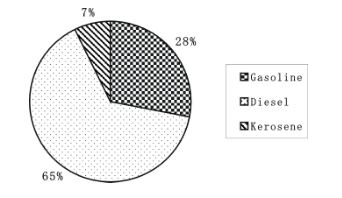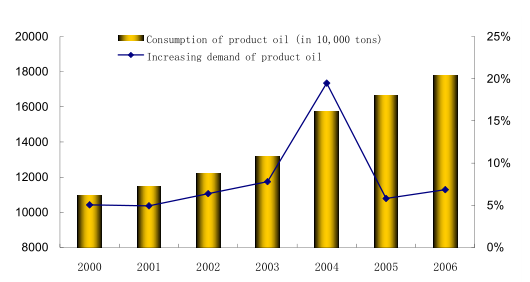Analysis and Forecast on Product Oil Market in the Second Half of 2006
Dec 13,2006
By Yang Jianlong& Zhou Wei
Research Report No 139, 2006
I. Demand for Oil Products Will Grow Rapidly
China’s apparent consumption of crude oil and finished oil products grew rapidly in the first half of 2006. It is expected that in the second half of the year, the demand for gasoline, kerosene and diesel will continue to grow rapidly at a faster year-on-year pace. According to the forecast based on the "Forecast Model for the Demand of Product Oil in China" by the Development Research Center of the State Council, the country’s apparent crude oil consumption[1] in 2006 will reach 332 million tons, which will be 9.9 percent[2]more or 3.8 percentage points faster than that in 2005. Meanwhile, the country’s apparent consumption ofproduct oil in 2006 is expected to reach 178 million tons, which will be 8.0 percent more or 3.3 percentage pointsfaster year-on-year. Specifically, the demand growth for gasoline and kerosene will be visibly higher. The annual gasoline demand will total 49.48 million tons, or 6.5 percent higher than in 2005. This growth rate is in sharp contrast with the 0.82 percent growth in 2005. Kerosene demand will rise 20.4 percent to reach 12.66 million tons, while diesel demand will rise 7.4 percent to reach 115 million tons (the growth rate was 6.8 percent for 2005). The diesel-gasoline ratio at the demand side will be 2.33, largely identical to that in 2005.

Chart 1 2006 Demand Structure ofProduct Oil
Source: Research Department of Industrial Economy of the Development Research Center of the State Council

Chart 2 Apparent Consumption ofProduct Oil 2000-2006
Source: Research Department of Industrial Economy of the Development Research Center of the State Council
The above growth structure indicates that while the growth of diesel consumption was exceptional on the 2005 market ofproduct oil, the market growth in 2006 will be driven by diverse forces, with the demands for all oil productsbeing visibly higher. The recovery growth of the gasoline and kerosene demands will bring a new look to the market. Specifically, the growth of gasoline demand will be mainly attributable to the vigorous development of the auto market and the new development of the civil aviation industry will also bring new demand for aviation kerosene. At the same time, diesel’s share of the overall consumption of all product oil will continue to be as high as 65 percent, and the development of the diesel-using industries will also further spur the growth of diesel demand.
1. The thriving auto market will drive up gasoline consumption
The fast growth of the market of gasoline-driven passenger vehicles in the first half of 2006 can be attributed to the following causes. First, the accumulated purchasing power began a massive release after the market had gone through adjustment for more than a year and the vehicle prices were basically reasonable. The growth was fast from a relatively low year-on-year base figure in 2005. Second, the state introduced a series of favorable policies. In particular, the removal of the ban on small-engine vehicles and the adjustment of consumption tax rate effectively guided market consumption orientation. The sales of small-engine vehicles went up steeply, resulting in a robust market growth. Third, the active operating tactics employed by auto-makers also strongly pushed up auto demand.
Apparently, most of the favorable factors are sustainable. It is expected that gasoline consumption in the second half of 2006 will continue to grow rapidly, only somewhat slower than in the first half of the year. This is mainly because the demand growth of the auto market will slow down slightly. First, although the massive release of the purchasing power in the first half of the year was encouraging, the month-on-month growth rate was declining. It is expected that the demand growth of gasoline-driven passenger vehicles in the second half of the year will drop to about 18 percent. Second, the adjustment of the consumption tax rate is unfavorable to the demand growth of middle- and high-grade vehicles. The demand deficit of the corresponding models at the beginning of the year will also adversely affect the auto consumption in the second half of the year. Third, the rising oil prices have also contained the demand of the auto market to some extent. But this impact is unlikely to be too serious in the short run, due to the income growth of the consumers and the state policy incentives to small-engine vehicles. Fourth, the market has certain expectation that prices will fall in the second half of the year. But influenced by the existing operating concepts and operating costs, the auto prices as a whole are unlikely to dip drastically in the second half of the year. The prices will continue the steady downward movement experienced in the first half of the year and are unlikely to cause consumers to hold the money and wait for the purchase.
2. Diesel demand will continue a steady growth amid divergent performances of the diesel-using industries
Driven by the vigorous development of the auto, shipping, construction and other industries, diesel demand will continue to grow steadily, with the pace being slightly faster than in 2005.
(1) The diesel-driven commercial vehicles are the main force of all diesel-driven vehicles and their demand growth will be higher in the second half of the year. Most diesel-driven vehicles are for commercial purposes and have certain characteristics of means of production. Compared with passenger vehicles, they are more prone to the influence of the macroeconomic situation (especially investment demand) and the industrial policies. Because of the high investment-driven GDP growth and the continuous improvement of the urban and rural transport infrastructure and road conditions in 2006, the growth of diesel-driven commercial vehicles went up sharply in the first half of the year. This trend is expected to continue in the second half for the following reasons. The trend that GDP growth is led by the secondary industry is increasingly tangible and the freight traffic will continue to grow; the renewal of highway buses this year and next year will be accelerated, with most of the passenger vehicles that were renewed following the qualification evaluation of the passenger transport enterprises in 2000 by the Ministry of Communications have all reached the age of renewal; the initial stage of the 11th Five-Year Plan is the peak period for infrastructure investment by governments at various levels. It is expected that the sales growth of diesel-driven commercial vehicles in the second half of 2006 will be about 13 percent.
(2) The vigorous development of the shipping industry will have a greater demand for diesel consumption. With increased investment in infrastructure construction and improved shipping capacity, the shipping industry will maintain its high demand and its business turnover will increase 13.5 percent in the second half of the year for the following reasons. First, the state policy to boost domestic demand has begun to take effect in the shipping industry. While the domestic demand for energy, raw materials and other bulk cargoes is robust, volumes of coal, iron ore and mineral building materials handled by the shipping industry have gone up tangibly. Second, the Yangtze River shipping is the main force of internal trade and has received priority support from the state. All the three economic belts in the eastern, central and western reaches of the river are places with rapid economic growth in 2006. Third, the state has clearly intensified support for inland shipping. Shipping is less polluting and conducive to environmental protection and conforms to the requirements of implementing the strategy for sustainable development and the building of a resource-effective and environment-friendly society.
…
If you need the full text, please leave a message on the website.
--------------------------------------------------------------------------------
[1] For this article, apparent consumption = production + import – export – (inventory change). Because inventory changes are taken into account, the data in this article are slightly different from those used in media reports.
[2] The data about oil products in 2005 mentioned in this article are based on the statistical bulletin on monthly consumption ofproduct oil compiled by the National Development and Reform Commission and are adjusted by the authors of this article.














